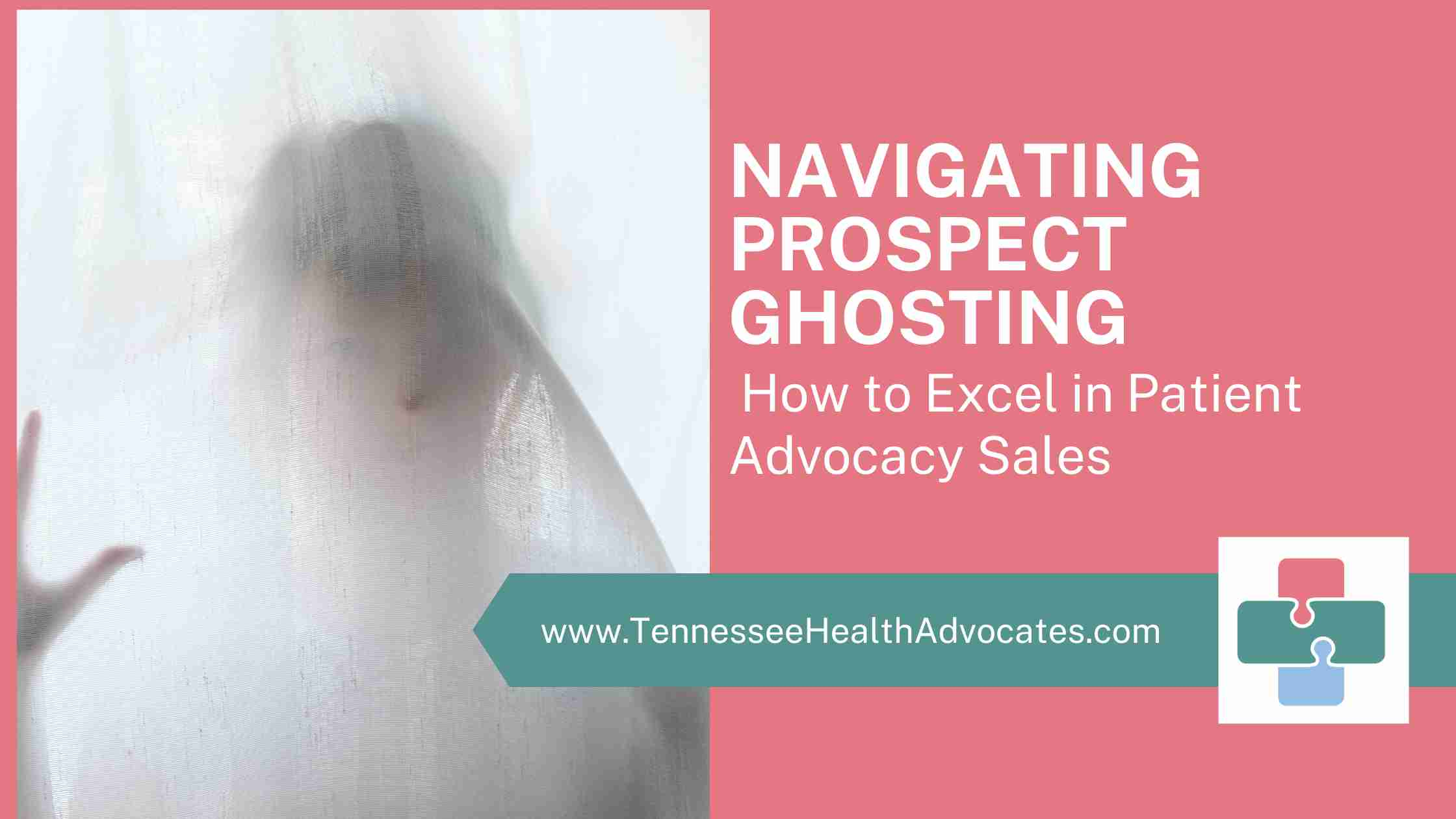Understanding Prospect Ghosting in Sales
In today’s hyper-connected world, where communication happens at the speed of light, the phenomenon of prospect ghosting has become increasingly prevalent, even in the realm of patient advocacy sales. Prospect Ghosting, in the context of sales, refers to the abrupt and unexplained disappearance of a prospect who was once engaged in the sales process. This phenomenon can be particularly frustrating for those of us who invest time, effort, and emotional energy into building relationships with potential clients. Understanding the dynamics of prospect ghosting is crucial for navigating the challenges it presents and maintaining a successful patient advocacy practice.
Defining Prospect Ghosting and Its Relevance in Patient Advocacy Sales
In the context of patient advocacy sales, ghosting occurs when a prospect suddenly stops responding to messages, emails, or phone calls, leaving you without any indication of their disinterest or reasons for withdrawing from the conversation. This silence can be deafening, leaving us in a state of uncertainty and self-doubt. The prospect, who was once enthusiastic about the services offered, seems to have vanished into thin air, leading to feelings of frustration and confusion on our part.
Common Reasons for Prospect Ghosting
While ghosting can be disheartening, it’s essential to recognize that there are various reasons why prospects may choose to disappear. One common reason is a lack of readiness or commitment on the part of the prospect. They might have initially shown interest in the services but later realized they weren’t fully prepared to engage in the patient advocacy process.
Additionally, prospects may encounter unexpected financial constraints or personal circumstances that hinder their ability to continue with the sales journey.
Another prevalent reason for prospect ghosting is a lack of alignment between the prospect’s needs and our services. Perhaps we failed to grasp the prospect’s unique challenges or didn’t effectively communicate how our services could address those specific concerns. Without a clear understanding of the prospect’s needs, we might not have demonstrated the value of our services, leading the prospect to lose interest.
Emphasizing the Impact of Prospect Ghosting on the Sales Process
Ghosting can have a profound impact on the sales process, both emotionally and practically. Emotionally, it can be demoralizing for those of us who invest time and effort in building connections with potential clients, only to see those efforts go unanswered. The lack of closure can lead to feelings of rejection and self-doubt, affecting our confidence in our sales abilities.
Practically, ghosting disrupts the sales pipeline and can hinder business growth. When prospects disappear without any explanation, it becomes challenging to accurately forecast and plan for future engagements. Time and resources invested in nurturing the relationship might seem wasted, impacting the overall efficiency of the patient advocacy practice.
Understanding ghosting and its implications in patient advocacy sales is vital for thriving in this dynamic field. By recognizing the reasons behind ghosting and its impact on the sales process, we can adopt strategies to address these challenges effectively. In the following sections, we will explore proactive approaches to prevent ghosting and responsive strategies to handle ghosting when it does occur. With the right insights and techniques, we can build resilient sales processes and navigate the uncertainties of ghosting, ultimately fostering sustainable business growth and success.
Strategies for Preventing Ghosting
Ghosting in patient advocacy sales can be disheartening, but with the right strategies, we can significantly reduce the likelihood of prospects vanishing without a trace. By building a strong foundation, engaging prospects in a meaningful way during the initial contact, and setting clear expectations, we can create an environment that fosters trust and open communication, making it less likely for prospects to ghost. Let’s explore these strategies in detail:
Build a Strong Foundation
- Establishing a Solid Online Presence: In today’s digital age, having a robust online presence is essential for any business, including patient advocacy practices. Prospects often research advocates online before engaging with them. Ensure your website is professional, informative, and user-friendly. Share relevant content, such as blog posts, articles, and educational resources that demonstrate your expertise and dedication to patient advocacy. An impressive online presence not only builds credibility but also provides a glimpse of the value you offer to potential clients.
- Utilizing Testimonials and Success Stories: Testimonials and success stories from satisfied clients can be powerful tools in preventing ghosting. When prospects see positive feedback from others who have benefited from your services, it instills confidence in your abilities and creates trust. Consider sharing testimonials on your website, social media platforms, and promotional materials. Personal success stories help prospects envision how your advocacy services can make a difference in their lives.
Engage Initial Contact
- Tailoring Outreach to Prospect’s Needs: Personalization is key to making a lasting impression during the initial contact. Before reaching out to prospects, research their specific needs and challenges. Tailor your outreach messages to address their unique concerns and demonstrate that you understand their situation. Avoid generic, one-size-fits-all approaches, as they may come across as impersonal and insincere.
- Using Personalized Messaging to Create a Connection: Beyond addressing their needs, focus on building a connection with prospects. Be authentic, empathetic, and genuinely interested in their well-being. Share relevant anecdotes or experiences that showcase your dedication to patient advocacy. Personal connections increase the likelihood of continued engagement and reduce the chances of prospects ghosting you.
Set Clear Expectations
- Communicating the Purpose and Value of Services: Clearly communicate the purpose and value of your patient advocacy services. Explain how your expertise can benefit the prospect and address their specific challenges. Provide a concise overview of the services you offer, emphasizing the positive outcomes they can expect. When prospects understand the value you bring to the table, they are more likely to remain engaged throughout the sales process.
- Managing Expectations for the Sales Process: Set realistic expectations for the sales process and the timeline for potential outcomes. Being transparent about what the prospect can expect at each stage of engagement helps manage their expectations. This includes informing them about the frequency of follow-up communications and the steps involved in working together. When prospects know what to anticipate, they are less likely to feel overwhelmed or uncertain, reducing the likelihood of ghosting.
Incorporating these strategies into your patient advocacy sales approach can significantly decrease the occurrence of ghosting and increase the chances of establishing meaningful connections with potential clients. By creating a foundation of trust, engagement, and clear communication, you position yourself as a trustworthy advocate and partner, setting the stage for successful and long-lasting client relationships. In the next section, we will explore how to respond effectively when ghosting does occur, ensuring you navigate the challenges with grace and professionalism.
Responding to Prospect Ghosting
Prospect ghosting is an unfortunate reality in patient advocacy sales, but it doesn’t have to spell the end of a potential client relationship. By responding to ghosting with professionalism, empathy, and respectful persistence, we can rekindle connections and navigate the complexities of re-engaging prospects. Let’s delve into the effective strategies for responding to prospect ghosting:
Analyze the Situation
- Assessing the Timing and Context of Prospect Ghosting: When a prospect goes silent, take a moment to consider the timing and context of their disappearance. Have there been any significant changes in their circumstances that might have led to their ghosting? Understanding the external factors that could be influencing their behavior can guide your response.
- Reflecting on Previous Actions or Communications: Review your previous interactions with the prospect. Were there any misunderstandings, miscommunications, or unaddressed concerns that might have contributed to their ghosting? Reflecting on your own actions and communications can provide insights into potential areas of improvement.
Following Up Professionally
- Sending Polite and Empathetic Follow-up Messages: Craft a follow-up message that strikes the right balance between professionalism and empathy. Acknowledge the prospect’s absence without placing blame or pressure. Express genuine concern for their well-being and interest in continuing the conversation. Your message should convey understanding and respect for their decision to step back temporarily.
- Providing Additional Information or Resources: In your follow-up message, offer to provide additional information or resources that might address any questions or concerns the prospect may have. This demonstrates your commitment to their needs and showcases your willingness to support them, even in the absence of immediate engagement.
Respectful Persistence
- Scheduling a Follow-up Call or Meeting: If the prospect’s response to your follow-up message is positive or even neutral, propose scheduling a follow-up call or meeting. This step shows your commitment to their needs and allows for a more personalized and direct conversation. Be flexible in accommodating their schedule and preferences.
- Balancing Persistence with Respect for the Prospect’s Boundaries: While persistence is important, it’s equally crucial to respect the prospect’s boundaries. Avoid bombarding them with messages or becoming overly insistent. If the prospect indicates that they need more time or space, gracefully acknowledge their request and let them know you’re available whenever they’re ready to reconnect.
Responding to prospect ghosting requires a delicate approach that combines understanding, patience, and the desire to genuinely assist. By analyzing the situation, offering professional follow-up, and respectfully persisting without crossing boundaries, you showcase your dedication to providing exceptional patient advocacy services.
Refining Your Sales Approach
In the dynamic landscape of patient advocacy sales, the journey towards success is marked by a commitment to continuous improvement and adaptability. By fine-tuning your sales approach, you can better connect with prospects, address their unique needs, and create lasting relationships. Let’s explore two key aspects of refining your sales approach:
Continuous Improvement
- Evaluating and Analyzing Your Sales Process: Regularly assess the effectiveness of your sales process. Identify areas of strength and opportunities for enhancement. Are there specific stages where prospects tend to disengage? By pinpointing these areas, you can implement targeted improvements that keep prospects engaged throughout the sales journey.
- Seeking Feedback from Prospects and Clients: Direct feedback from prospects and clients is a treasure trove of insights. Encourage open communication and ask for their thoughts on their experience with your sales process. Their input can reveal valuable details about what resonates with them and what might need adjustments.
Adapting to Different Prospects
- Recognizing and Adapting to Unique Needs: Each prospect is a distinct individual with specific challenges and requirements. Take the time to truly understand their situation and concerns. Tailor your approach to address their unique needs, showing that you are genuinely invested in helping them navigate their healthcare journey.
- Flexibility in Communication and Sales Pitch: Flexibility is key when interacting with prospects. Adapt your communication style to match their preferences, whether they prefer emails, phone calls, or face-to-face meetings. Similarly, customize your sales pitch to align with their interests and concerns. A flexible approach demonstrates your commitment to meeting prospects where they are, fostering a stronger connection.
By embracing continuous improvement and adapting to the diverse needs of your prospects, you position yourself as a patient advocate who is attentive, responsive, and dedicated. The journey towards refining your sales approach is a path of growth, ensuring that you consistently deliver value and resonate with your clients.
Conclusion
In the realm of patient advocacy sales, the pursuit of meaningful connections with potential clients is both rewarding and challenging. The specter of prospect ghosting can cast a shadow on even the most promising relationships, but armed with the strategies outlined here, you can navigate these challenges with finesse. By fostering a strong foundation, responding to ghosting professionally, and refining your sales approach, you can build resilient connections that transcend the uncertainty of prospect ghosting. To further empower your patient advocacy journey, I invite you to join me in The Circle – a vibrant community for independent patient advocates offering invaluable tools, resources, and support. Together, let’s shape the future of patient advocacy and unlock new heights of success.


